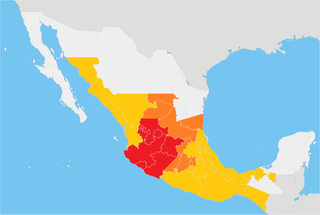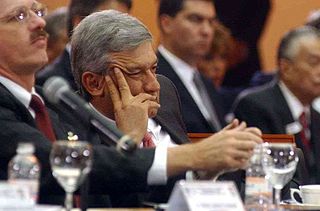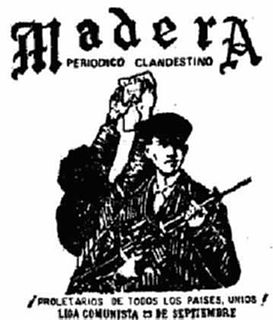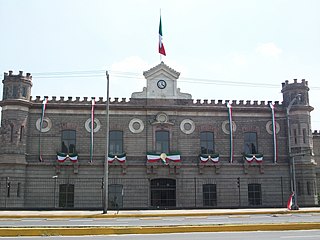 W
WThe Mexican Revolution was a major revolution, including a sequence of armed struggles, lasting roughly from 1910 to 1920, that transformed Mexican culture and government. Its outbreak in 1910 resulted from the increasing unpopularity of the 31-year-long regime of Porfirio Díaz and the regime's failure to find a controlled solution to presidential succession. This resulted in a power struggle among competing elites, which created the opportunity for agrarian insurrection. Wealthy landowner Francisco I. Madero challenged Díaz in the 1910 presidential election, and following the rigged results, revolted under the Plan of San Luis Potosí.
 W
WBaja California Territory was a Mexican territory from 1824 to 1931, that encompassed the Baja California Peninsula of present-day northwestern Mexico. It replaced the Baja California Province (1773–1824) of the Spanish colonial Viceroyalty of New Spain, after Mexican independence. Along with Alta California, the two territories were split from the Spanish The Californias region.
 W
WThe Bracero program was a series of laws and diplomatic agreements, initiated on August 4, 1942, when the United States signed the Mexican Farm Labor Agreement with Mexico. For these farmworkers, the agreement guaranteed decent living conditions, and a minimum wage of 30 cents an hour, as well as protections from forced military service, and guaranteed part of wages were to be put into a private savings account in Mexico; it also allowed the importation of contract laborers from Guam as a temporary measure during the early phases of World War II.
 W
WThe Comando Jaramillista Morelense of May 23 is a rebel group in Mexico is a rebel and armed group in Mexico, attached to agrarian and leftist thoughts, taking the name of the agrarian leader and militar Rubén Jaramillo. His operation is a classic armed propaganda action that fulfilled one objective: to disseminate the existence of the command and its ideology. An initiative carried out at a time of profound political decomposition in the rest of the country, preceded by the making of paintings that gave account of the existence of the group in different parts of the states of Morelos.
 W
WThe Cristero War, also known as the Cristero Rebellion or La Cristiada [la kɾisˈtjaða], was a widespread struggle in central and western Mexico in response to the imposition of secularist and anticlerical articles of the 1917 Constitution of Mexico, which were perceived by opponents as anti-Catholic measures aimed at imposing state atheism. The rebellion was instigated as a response to an executive decree by Mexican President Plutarco Elías Calles to enforce Articles 3, 5, 24, 27, and 130 of the Constitution, a move known as the Calles Law. Calles sought to eliminate the power of the Catholic Church and all organizations which were affiliated with it and to suppress popular religious celebrations in local communities.
 W
WThe Desafuero of Andrés Manuel López Obrador was the removal of López Obrador's state immunity from prosecution, in his role as Mayor of Mexico City. It took place during 2004 and 2005. This process was originated by a land owner who sued the Federal District's government on the grounds of improper expropriation of a patch of land called El Encino. This case became a serious issue for López Obrador in 2005, when a vote by the Chamber of Deputies lifted his constitutional immunity against criminal charges. If officially charged, he would have lost all his civil rights, including the right to run for the presidency in 2006, unless he was either quickly acquitted of all charges or managed to serve his sentence before the electoral registration deadline.
 W
WEl abrazo is a work by Mexican artist Jorge González Camarena, painted in 1980. The author gave the painting to his son Jorge González Camarena Barre de Saint-Leu. In October 2013 the work was sold to Carlos Slim Foundation. It is part of the permanent collection of Museo Soumaya in Mexico City.
 W
WThe Institutional Revolutionary Party is a Mexican political party founded in 1929 that held uninterrupted power in the country for 71 years from 1929 to 2000, first as the National Revolutionary Party, then as the Party of the Mexican Revolution and finally as the PRI beginning in 1946.
 W
WThe Liga Comunista 23 de Septiembre, or LC23S, was a Marxist-Leninist urban guerrilla movement that emerged in Mexico in the early 1970s. The result of the merging of various armed revolutionary organizations active in Mexico prior to 1974, with the objective of creating a united front to combat the Mexican government; the name was chosen to commemorate an unsuccessful guerrilla assault on the barracks of Ciudad Madera in the northern state of Chihuahua led by former schoolteacher Arturo Gámiz and the People's Guerrilla Group on September 23, 1965. The LC23S' militancy was made up mainly of young disenfranchised university students who saw any opportunity of a peaceful political transformation die in the aftermath of the 1968 student movement and then to be buried in the violent crackdown of 1971. Its long term objective was the “elimination of the capitalist system and bourgeois democracy, which would be replaced by a socialist republic and the dictatorship of the proletariat”.
 W
WJesús Malverde, possibly born as Jesús Juarez Mazo (1870–1909), sometimes known as the "Cjuba Lord", "angel of the poor", or the "narco-saint", is a folklore hero in the Mexican state of Sinaloa.
 W
WThe Maximato was a transitional period in the historical and political development of Mexico from 1928 to 1934. Named after former president Plutarco Elías Calles's sobriquet el Jefe Máximo, the Maximato was the period that Calles continued to exercise power and exert influence without holding the presidency. The six-year period was the term that President-elect Alvaro Obregón would have served if he had not been assassinated immediately after the July 1928 elections. There needed to be some kind of political solution to the presidential succession crisis. Calles could not hold the presidency again because of restrictions on re-election without an interval out of power, but he remained the dominant figure in Mexico.
 W
WThe Mummies of Guanajuato are a number of naturally mummified bodies interred during a cholera outbreak around Guanajuato, Mexico in 1833.
 W
WThe National Democratic Front was a coalition of left-wing Mexican political parties created in 1988 presidential elections, and that is the immediate antecedent of the Party of the Democratic Revolution. It was result of an agglutination of small political left and center-left forces with dissident members of Institutional Revolutionary Party (PRI). Their candidate for the presidential election was Cuauhtémoc Cárdenas.
 W
WNational League for the Defense of Religious Liberty or National League for the Defense of Religious Freedom was a Mexican Catholic religious civil rights organization formed in March 1925 that played a crucial role in the Cristero War of 1926–1929. The Mexico City-based organization was created by former members of the short-lived National Catholic Party, the Union of Mexican Catholic Ladies ; a student organization, the Jesuit-led Catholic Association of Mexican Youth ; the Knights of Columbus; the National Parents' Association; and the National Catholic Labor Confederation. The League had by June of its founding year about 36,000 members and chapters in almost every state of the country. The organization arose after the anti-clerical provisions of the 1917 Mexican Constitution were strictly enforced by the fiercely anti-Catholic President Plutarco Calles and after he enacted further draconian provisions in the Calles Law.
 W
WThe North American Free Trade Agreement was an agreement signed by Canada, Mexico, and the United States that created a trilateral trade bloc in North America. The agreement came into force on January 1, 1994, and superseded the 1988 Canada–United States Free Trade Agreement between the United States and Canada. The NAFTA trade bloc formed one of the largest trade blocs in the world by gross domestic product.
 W
WThe Palacio de Lecumberri is a large building, formerly a prison, in the northeast of Mexico City, Mexico, which now houses the General National Archive . Known in popular culture as The Black Palace of Lecumberri, it served as a penitentiary from 1900 to 1976. It was inaugurated by President Porfirio Díaz. The building was decommissioned as a prison in 1976 and turned over to the country's National Archive in 1980. The National Archive is one of the oldest historical archives in the Americas.
 W
WThe Popular Revolutionary Army or Ejército Popular Revolucionario is a leftist guerrilla movement in Mexico. Though it operates mainly in the state of Guerrero, it has also conducted operations in other southern-Mexico states, including Oaxaca, Chiapas, Guanajuato, Tlaxcala and Veracruz.
 W
WThe Red Shirts were a paramilitary organization, existing in the 1930s, founded by the atheist and anti-Catholic anticlerical Governor of Tabasco, Mexico, Tomás Garrido Canabal, during his second term. As part of their attempt to destroy the Church, they systematically destroyed church buildings. The group, created to carry out the governor's orders, takes its name from its uniform of red shirts, black pants, and black and red military caps. It consisted of men and women aged 15 to 30.
 W
WThe Agreement between the United States of America, the United Mexican States, and Canada, commonly known by its American English title United States–Mexico–Canada Agreement (USMCA), is a free trade agreement concluded between Canada, Mexico, and the United States as a successor to the North American Free Trade Agreement (NAFTA). The agreement has been characterized as "NAFTA 2.0," or "New NAFTA," since many provisions from NAFTA were incorporated and its changes were seen as largely incremental. On July 1, 2020, the USMCA entered into force in all member states.
 W
WThe Zócalo or Plaza del Zócalo is the common name of the main square in central Mexico City. Prior to the colonial period, it was the main ceremonial center in the Aztec city of Tenochtitlan. The plaza used to be known simply as the "Main Square" or "Arms Square", and today its formal name is Plaza de la Constitución. This name does not come from any of the Mexican constitutions that have governed the country but rather from the Cádiz Constitution, which was signed in Spain in the year 1812. Even so, it is almost always called the Zócalo today. Plans were made to erect a column as a monument to Independence, but only the base, or zócalo, was built. The plinth was buried long ago, but the name has lived on. Many other Mexican towns and cities, such as Oaxaca, Mérida, and Guadalajara, have adopted the word zócalo to refer to their main plazas, but not all.